Seven Impossible Interviews #74 (Summer Blog Blast Tour edition): Javaka Steptoe
 May 23rd, 2008 by Eisha and Jules
May 23rd, 2008 by Eisha and Jules
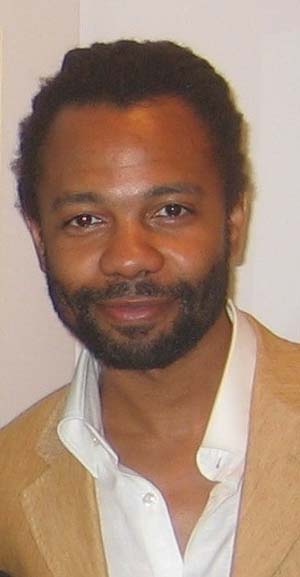 Welcome to the fifth and final day of the Summer Blog Blast Tour. We hope you’ve enjoyed all the interviews as much as we have.
Welcome to the fifth and final day of the Summer Blog Blast Tour. We hope you’ve enjoyed all the interviews as much as we have.
For our final SBBT interview, we’re thrilled to be talking with the hardest-working man in picture books: author/illustrator Javaka Steptoe. The talented Mr. Steptoe sprang onto the picture book scene in 1997 as the illustrator of the poetry anthology In Daddy’s Arms I Am Tall: African Americans Celebrating Fathers (Lee & Low). His mixed-media collages — created from “paper with pastel; applique; and a multitude of found objects, including fabric, coins, seashells, buttons, sand, seeds, and leaves” (School Library Journal) won him instant acclaim – and the Coretta Scott King Illustrator Award for 1998. As SLJ went on to say: “The artwork vibrates with emotion; even the simplest pieces, showing torn-paper figures on a solid background, capture the powerful bond between parent and child.”
Next up was the daunting task of re-illustrating a classic: Charlotte Zolotow’s sweet ode to siblinghood Do You Know What I’ll Do? (HarperCollins, 2000), originally illustrated by Garth Williams. The updated classic won Steptoe further accolades: Publisher’s Weekly raved “…His stunning illustrations… create layered, almost three-dimensional portraits of the striking African-American siblings. Their love for each other is tangible, yet he injects the same playfulness and humor inherent in the text.”
 Steptoe followed this up by collaborating with Nikki Grimes on the poetry collection A Pocketful of Poems (Clarion, 2001). School Library Journal praised the “playful and thoroughly successful pairing of words and pictures,” stating that his illustrations “give the book an urban, upbeat, and contemporary look.”
Steptoe followed this up by collaborating with Nikki Grimes on the poetry collection A Pocketful of Poems (Clarion, 2001). School Library Journal praised the “playful and thoroughly successful pairing of words and pictures,” stating that his illustrations “give the book an urban, upbeat, and contemporary look.”
For his next project, Steptoe made the leap from illustrator to author/illustrator, in his original picture book The Jones Family Express (Lee & Low, 2003). The story of Steven, a boy who creates the perfect gift for his world-traveling aunt using a discarded model train and a lot of imagination, is the perfect vehicle for Steptoe’s collage art. Says SLJ: “Young readers will identify with Steven’s struggle to choose a perfect present and his excitement over Aunt Carolyn’s invitation for him to join her travels — but it is the illustrations that will cause them to linger over this book and delight in the colorful details.”
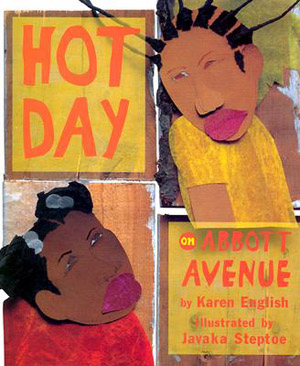 In 2004 he teamed up with author Karen English to produce Hot Day on Abbott Avenue (Clarion 2004). Booklist praised the story of two best friends who are best-friends-no-more — until a game of double-dutch lures them out of their stand-off, saying that “it is Steptoe’s stunning, mixed-media illustrations that make the book soar like a champion jumper.”
In 2004 he teamed up with author Karen English to produce Hot Day on Abbott Avenue (Clarion 2004). Booklist praised the story of two best friends who are best-friends-no-more — until a game of double-dutch lures them out of their stand-off, saying that “it is Steptoe’s stunning, mixed-media illustrations that make the book soar like a champion jumper.”
Most recently fans were treated to Rain Play (Henry Holt, 2008), a gorgeous collaboration with Cynthia Cotten about kids — what else? — playing in the rain. It made a Javaka Steptoe-convert out of Betsy Bird, a.k.a. Fuse #8, who was amazed by his ability to capture perspective with his tissue-paper collage: “…he’s constantly shifting our point of view, drawing close to the action and then far. We’re up above them as they scurry away like ants, and now we’re right up in their faces, practically able to see their non-existent pores.”
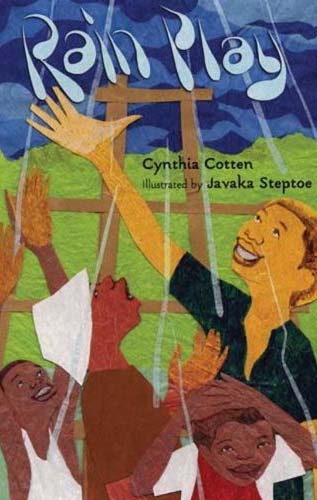 Javaka Steptoe grew up in Brooklyn, in an artistic family: his mother, Stephanie Douglas, was an artist, and his father was the acclaimed children’s book author/illustrator John Steptoe, for whom the Coretta Scott King offshoot award for new talent is named. When he isn’t illustrating or writing, he’s probably visiting a school or a library – he’s big on art education and interacting with the next generation of illustrators. He can also frequently be found teaching art workshops at the Brooklyn Museum.
Javaka Steptoe grew up in Brooklyn, in an artistic family: his mother, Stephanie Douglas, was an artist, and his father was the acclaimed children’s book author/illustrator John Steptoe, for whom the Coretta Scott King offshoot award for new talent is named. When he isn’t illustrating or writing, he’s probably visiting a school or a library – he’s big on art education and interacting with the next generation of illustrators. He can also frequently be found teaching art workshops at the Brooklyn Museum.
Are you ready to meet the man himself? So are we. We thank Javaka Steptoe for taking time out from all his current works-in-progress to talk with us, and hope you enjoy the interview.
7-Imp: You’ve said before, “{b}eing the son of John Steptoe, people always asked if I was planning to follow in my father’s footsteps. Sometimes I would say yes, sometimes I would say no. But I realized though I might walk a similar path, I will always be making my own footsteps.” Was it a struggle for you, when starting out as an illustrator, to distinguish yourself from your father or to strike out on your own, unique path? Looking back, what do you think your parents did to encourage your artistic abilities?
Javaka: Inherently, I think the fact that both my parents were artists [meant] an artistic perspective was bound to seep through.
My parents took us to museums, art shows, and involved us in lots of after school activities, most of them art programs because that’s what they knew; but we also took martial arts, gymnastics, and all sorts of other classes, so life was not limited to art. But I would never say my life was mainstream in the least, not even by today’s standards.
Out of my siblings I was the one to ask my mom or dad for paper and pencil to draw because it was something that I loved, and they helped to nurture that talent in me. I used what I learned from them as a platform and because I am my own person with my particular taste, likes, dislikes, and ideas I forged my own path. So, when I think of my father, I don’t think of him in terms of competition; I think of him as someone who taught me a lot about art: how to draw hands, eyes, and lips. Someone who helped to instill my beliefs and moral responsibilities in respect to children’s book art.
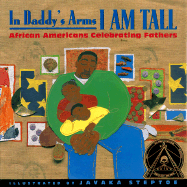 The art I make is about my own personal journey. It is influenced by many artists, past and present, but it is driven by a feeling. Sometimes it is the compulsion to explore a medium, and other times it is about the concept. But, all of the time it is about overcoming the challenge of telling the story without words. Filling in all the blanks so that the reader is satisfied with the sum of all its parts. I’m a scientist: I poke it, prod it, and test to see how far I can take it.
The art I make is about my own personal journey. It is influenced by many artists, past and present, but it is driven by a feeling. Sometimes it is the compulsion to explore a medium, and other times it is about the concept. But, all of the time it is about overcoming the challenge of telling the story without words. Filling in all the blanks so that the reader is satisfied with the sum of all its parts. I’m a scientist: I poke it, prod it, and test to see how far I can take it.
7-Imp: Can you briefly tell us about your road to publication?
Javaka: I got my first contract because of Pat Cummings. She told me about Lee & Low; I gave them a call. They liked my work and called me back 6 months later with a contract. I showed them way too much work, it was so unprofessional; but they loved these charcoal sketches that I did of men with children, and the rest is history.
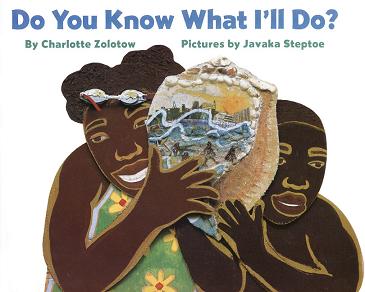 7-Imp: What is it about the medium of collage that draws you to it? And to your use of mixed media, what Publishers Weekly described in their review of Do You Know What I’ll Do? as “stunning illustrations, comprised of painted plywood, cardboard and paper, along with fabric, ribbons, buttons, seashells and so on {which} create layered, almost three-dimensional portraits of the striking African-American siblings.”
7-Imp: What is it about the medium of collage that draws you to it? And to your use of mixed media, what Publishers Weekly described in their review of Do You Know What I’ll Do? as “stunning illustrations, comprised of painted plywood, cardboard and paper, along with fabric, ribbons, buttons, seashells and so on {which} create layered, almost three-dimensional portraits of the striking African-American siblings.”
Javaka: I use collage because it draws people in. It is an interactive guessing game adding another layer of meaning to the book. You use an object, any object. This object has one layer of meaning (the original idea and history of that object). Then through the magic of collage it can become something totally different because of its position, size, color, or how it has been physically distorted in any other way within the work. It’s like a magic trick. During school visits people always want confirmation as to what I used and how I created the effect, and if they guessed correct they feel really good.
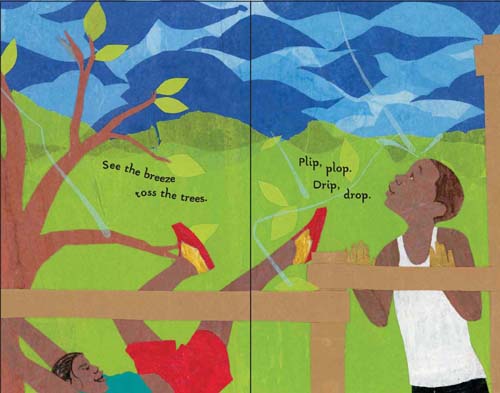
7-Imp: What exactly is your process when you are illustrating a book? You can start wherever you’d like when answering: getting initial ideas, starting to illustrate, or even what it’s like under deadline, etc. Do you outline a great deal of the book before you illustrate or just let your muse lead you on and see where you end up? Was the process any different for the book you also wrote yourself, The Jones Family Express?
 Javaka: Creating a book for me is like giving birth. It’s a rhythm of going in and pushing out then going in a little deeper and pushing out a little more. When you get down to the last breath after being in labor for 16 hours, feeling like you want to give up, you brace yourself for one more push. Then, it’s the happiest feeling in all the world, especially if you have a pretty baby. I never totally plan a book out from beginning to end. I don’t know what the book is going to look like until I bring it in. I work in steps, so the plan is only a skeleton plan, and the completion of one step dictates the next step. It’s not the best way to work under a deadline but I get great results.
Javaka: Creating a book for me is like giving birth. It’s a rhythm of going in and pushing out then going in a little deeper and pushing out a little more. When you get down to the last breath after being in labor for 16 hours, feeling like you want to give up, you brace yourself for one more push. Then, it’s the happiest feeling in all the world, especially if you have a pretty baby. I never totally plan a book out from beginning to end. I don’t know what the book is going to look like until I bring it in. I work in steps, so the plan is only a skeleton plan, and the completion of one step dictates the next step. It’s not the best way to work under a deadline but I get great results.
7-Imp: On that note, do you find it challenging – or different in any way – to illustrate poetry anthologies, such as with 1997’s In Daddy’s Arms I Am Tall and Nikki Grimes’s A Pocketful of Poems from 2001 (as opposed to illustrating fiction narratives)? And did you feel pressure of any kind when re-creating the illustrations for Charlotte Zolotow’s Do You Know What I’ll Do?, originally illustrated by Garth Williams?
Javaka: Poetry is easy: you have more freedom, each page can be anything you want. With a continuous story you have to be more selective because you have more boundaries and you don’t want lulls in the visual flow of the story. When I choose stories I look for excitement.
The pressure I felt with Do You Know What I’ll Do? had more to do with the success of my first book. This was my second contract, the second book that I was illustrating, and In Daddy’s Arms received a CSK. I did not want to become a one hit wonder. I no longer have that fear, but what I am after now is a Caldecott, then a Newbery.
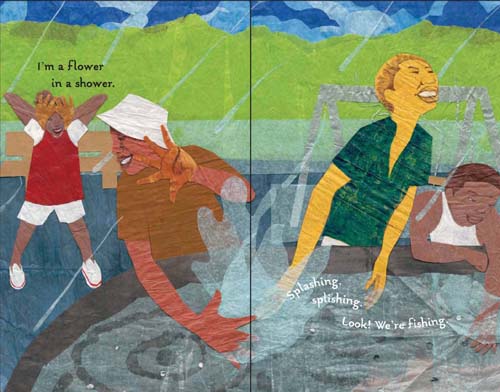
7-Imp: I love the illustrations in Rain Play. In her review of it, Betsy Bird at School Library Journal praised the art work for its depth, which “is hard when all you’ve got to work with is a bunch of practically two-dimensional paper pieces,” she wrote. Can you talk to us a bit about the creation of the illustrations for this new title and what drew you to Cotten’s story of a rainy day of play?
Javaka: When illustrating, the only thing I worry about is being excited. I look for something within the story that makes me want to be personally invested in wanting to retell the story. You spend six months to a year on a book. Upon publication you’re telling and retelling the story, hopefully for a long while, so it should speak to you in some way.
Rain Play was fun to work on because it reminded me of the rainy day after grocery shopping Dad decided to play with my sister and me in the rain instead of going inside and putting the food away. It reminds me of the Coke commercial with the kids playing in the rain. It reminds me of playing in the Johnny-pump, or sprinklers in the summer time, or having water fights in the pool. It starts with a thought, a spark. It’s spontaneous, it’s beautiful, it’s an experience that we all have and it is so natural. Rain is not all gray skies, it’s also refreshing nourishing growth. It was a fun story to illustrate.
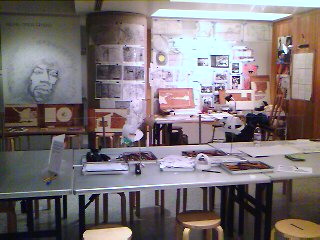 7-Imp: Describe your studio or usual work space for us.
7-Imp: Describe your studio or usual work space for us.
Javaka: My studio is a mess when I’m working and always transforming to fit my needs. [Pictured here] is my studio at the Seattle Art Museum [and my] Jimi Hendrix book in progress.
7-Imp: Tell us what your school visits are like and if they inform your work as an illustrator at all.
Javaka: With school visits I have fun. I like to crack jokes and make people laugh. I like to tell the truth and give real answers. These kids out here are smart, they deal with a lot of advanced concepts in their daily lives. I respect that and try to give them as much as possible.
7-Imp: Are there any new titles/projects you might be working on now that you can tell us about?
Javaka: New titles are Ameri and Odett (Scholastic winter ’08-’09), What’s So Special About Me Mom (Jump at the Sun ’09), Jimi Hendrix (Clarion ’09), and my super star 2pac book yet to be titled with Candlewick ’10. Plan to see lots from me.
7-Imp: What turns you on creatively, spiritually or emotionally?
Javaka: My turn-ons are learning and solving problems.
7-Imp: What turns you off?
Javaka: My turn-offs are TV and drugs. TV turns me into a zombie, and I like being in control of myself so I don’t do drugs.
7-Imp: What sound or noise do you love?
Javaka: Bells.
7-Imp: What sound or noise do you hate?
Javaka: Scratching sounds when you’re home alone and it’s not you scratching.
7-Imp: What profession other than your own would you like to attempt?
Javaka: I could do stand-up or be a brain surgeon.
7-Imp: What profession would you not like to do?
Javaka: Would not want to be a bathroom attendant.
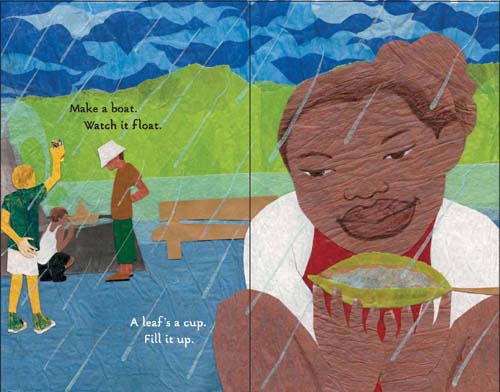
* Javaka’s website.
* “Book Talk with Javaka Steptoe.” Lee & Low.
* “An Interview with Javaka Steptoe.” Brooklyn Expedition.
* “Interview with Javaka Steptoe” by Yvonne Terry at ChickenBones: A Journal for Literary & Artistic African-American Themes.
* “Children’s Author/Illustrator: Javaka Steptoe.” Article at Answers.com.
Varian Johnson at Finding Wonderland
Jincy Willett at Shaken & Stirred
John Grandits at Writing & Ruminating
Meg Burden at Bookshelves of Doom
Gary D. Schmidt at Miss Erin
Mary Hooper at Interactive Reader
Illustrations from RAIN PLAY. Copyright © 2008 Cynthia Cotten. Illustration © 2008 by Javaka Steptoe. Reproduced by permission of the publisher, Henry Holt & Co. All rights reserved.

This one was worth the wait – just wonderful guys. Thanks so much for bringing him to our collective attention!
(And don’t forget Jackie’s interview at Interactive Reader with Mary Hooper!)
I have to admit that I’m never keen to describe anything as childbirth, having never given birth and then hearing a guy describe something as birth…? Usually that gets a big “Excuse me?” from me. But honestly? This process of layering — figuring out where paper, paint, seeds or leaves might go best — building the art from the inside out — this might really just BE like bringing something to life — from inside the consciousness into the larger world.
This final result is AMAZING.
I am really tempted to get two copies of Do You Know What I’ll Do? and frame the pages of one and have the other just to read. What a splendid artist and an unique person. Thanks for another revealing and happily picture-full interview.
Oops! Thanks, Colleen, I added it.
TadMack, I know, it’s an audacious analogy, but I think it’s probably pretty apt too. Thanks for visiting!
I agree with Tanita that I don’t usually like describing something as childbirth – particularly in the semi-graphic way that Javaka did – and yet I totally got what he was saying, and that’s the portion of this interview that will be featured this Sunday in my Quoteskimming post. (I’m not skimming from every interview, btw – just the bits that really sang to me. And boy, did this interview sing!)
IN.SPI.RED.
Holy moly….
I just have to add that I can’t fllippin’ wait to see his forthcoming books — Jimi Hendrix, Tupac. Javaka’s art work makes me wish I were an artist, I can hardly stand it. Every time I look at his books, I see something new in his illustrations. Each and every time.
I met him briefly once at the Alex Haley Farm during a Children’s Defense Fund weekend children’s lit event. He was very personable with the children there, making art with them and generally sharing his talents.
[…] Javaka Steptoe (interviewed May 23), pictured left: “…{W}hen I think of my father, I don’t think of him in terms of […]
[…] that one lovely excerpt how Golio infuses the text with a lyricism that just…well, sings? And Javaka Steptoe’s artwork? Now, I’m biased. I’ve always been a big fan of his mixed-media collages. But […]
[…] Javako Steptoe…with a nice interview with him at Seven Impossible Things Before Breakfast… […]
[…] over at Kirkus, I talked with Javaka Steptoe (who visited 7-Imp back in 2008), where we discuss his biography of Jean-Michel Basquiat, Radiant Child (Little, Brown, October […]